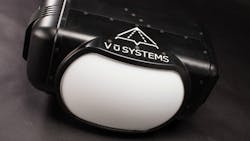Passive millimeter wave sensor allows pilots to see through rain and fog
A new passive millimeter wave sensor called the Vū Cube, designed to enhance aircraft pilots’ vision, was unveiled at the 2019 National Business Aviation Association convention. The Vū Cube, developed by Vū Systems (Morrisville, NC, USA; www.vusystems.com), can see airfields through rain, clouds, and fog at a range of several miles, aiding pilots in lining up runway approaches during poor visibility conditions.
Millimeter wave scanning is the basis of full-body imaging devices deployed at airport security checkpoints. The wavelengths of millimeter waves are large enough to pass through most materials, like clothing. The full-body scanner projects millimeter waves onto the subject and the waves are reflected either by the subject’s skin, or by any objects being carried by the person. The scanner can therefore detect objects under the subject’s clothes.
The Vū Cube operates by the passive method of the same principle, reading thermal energy in the millimeter wave part of the electromagnetic spectrum. The millimeter wave emissions reflected off a ground object like an airport runway are warmer than emissions reflecting off particles in the air. Fog and cloud particles are between 10 and 100 μm in size. The Vū Cube reads thermal energy in 3000-μm wavelengths that cut through fog and cloud particles, thus allowing the sensor to detect runways and other objects even through rain and fog.
“The resolution of the Vū Cube camera design is such that it resolves runways, taxiways, roads, and other features,” says Stedman Stevens, CEO of Vū Systems. “For example, you can easily see people and vehicles when close by, and at distances on approach see the runway and taxiways and in some cases the mechanical structures that hold the approach lighting systems in front of the runway.”
The Vū Cube weighs less than 30 pounds, measures 17.75 x 9.5 x 10 inches, and is mounted within an aircraft’s radome in order to have a clear forward view. Vū Systems has been developing the technology since 2013.
On October 22, Saab (Stockholm, Sweden; www.saab.com) announced that it will be manufacturing Vū Cubes to use in the company’s Next Generation EFVS (enhanced flight vision system), which combines PMMW and infrared sensors with a synthetic vision system (SVS). SVS is essentially a terrain database with some level of man-made objects added, says Stevens.
The integrated image is then presented in the pilot’s head-up display. Saab has tested the new EFVS on a King Air 200 aircraft during more than 100 instrument approaches.
Related stories:
Vision system allows crews to see through walls of armored vehicles
Dual-camera vision system designed to allow automatic landings at small airfields
Researchers at MIT develop system to assist autonomous vehicles in bad driving conditions
Share your vision-related news by contacting Dennis Scimeca, Associate Editor, Vision Systems Design
SUBSCRIBE TO OUR NEWSLETTERS
About the Author

Dennis Scimeca
Dennis Scimeca is a veteran technology journalist with expertise in interactive entertainment and virtual reality. At Vision Systems Design, Dennis covered machine vision and image processing with an eye toward leading-edge technologies and practical applications for making a better world. Currently, he is the senior editor for technology at IndustryWeek, a partner publication to Vision Systems Design.
